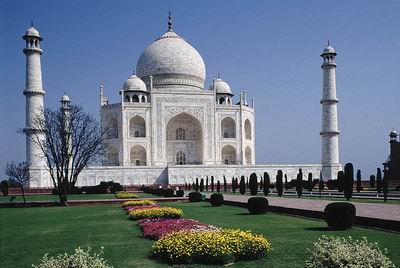
|
|
Taj Mahal
|
Indian experts have begun a six-month project to clean the white marble archways, carvings and crannies of Taj Mahal --the world's greatest monument to love by coating them in a special mud.
The monumental face pack consists of multani mitti, or fuller's earth, a lime-rich clay found across northern India and used in many face masks and body treatments.
K.S. Rana, director of the science department of the Archaeological Survey of India (ASI),said: “We will leave it overnight and then, the moment it starts drying, we will remove it, just like a face pack.
“The marble of the Taj Mahal is quite intact — it is very high quality. There is just some yellowing in the arched areas and other parts not exposed to the rain. The mud is being used to clean only those areas.”
The Taj complex was completed in 1653 by Shah Jahan, the Mogul emperor, in memory of Mumtaz Mahal, his second wife. It is India's top tourist site, attracting three million visitors every year.
Rising levels of dust and industrial pollutants from the surrounding city of Agra, 130 miles (210km) southeast of Delhi, have stained some of its white marble surfaces yellow.
The mud treatment, which costs about £115,000, was first tried six years ago, according to the ASI.
Some experts argue that the mud causes variations in the marble's whiteness and exposes it to fungus and even worse staining, but the ASI says that it is the only way to clean it without causing serious damage.
This year local authorities began a simultaneous campaign to clean up the surroundings of the Taj by demolishing illegal structures, banning squatting and restricting rickshaws to designated areas.
Dr Rana said that his team of two dozen experts had already erected the first set of scaffolding on a small section of the World Heritage site and would start work in the next few days.
The work would continue until late March and resume in January next year for another three months, but the monument would remain open to the public throughout that time, he said.
(Agencies) |
印度泰姬陵堪称世界上最伟大的爱情纪念碑。日前,印度有关专家开始对泰姬陵的表面进行翻新,他们将在泰姬陵的大理石拱门、雕刻和裂缝处敷上一层特制的粘土。整个翻新工程将持续六个月。
这种特制“面膜”的主要成分是“漂白土”。漂白土产于印度北部,是一种富含石灰石的粘土,很多面膜和印度草药护肤品中都含有这种成分。
印度考古研究所主任K·S·拉纳说:“涂在表层的粘土将保留一夜,等它慢慢干了之后,我们就把它剥下来,就和做面膜一样。”
“泰姬陵的大理石质量很好,所以现在依然保存完好。只是拱门处和未经过雨水清洗的地方有些发黄,因此翻新工程也仅限于这些地方。”
泰姬陵于1653年建成,是印度莫卧儿王朝君主沙贾汗为了纪念他的爱妃泰吉•马哈尔所建。泰姬陵是印度最著名的旅游景点,每年都吸引了300万名游客前来观赏。
泰姬陵位于距新德里东南130英里(210公里)的阿格拉市,由于阿格拉周边地区的粉尘和工业污染日益严重,泰姬陵白色大理石表面的一些地方开始发黄。
据印度考古研究所介绍,“面膜”翻新工程将耗资约11.5万英镑,这一方法于六年前首次试用。
一些专家质疑这种办法会影响大理石的洁白度,滋生菌类,反而会使大理石面变得更脏,但印度考古研究所称这是唯一不会对泰姬陵造成严重破坏的清洗办法。
与此同时,当地政府今年开始整顿泰姬陵的周围环境——违法建筑被清除、摩托车被禁止通行,黄包车只能在指定区域内活动。
拉纳说,目前20多名专家已在该世界遗产景点(即泰姬陵)的一小部分搭好了首批脚手架,并将在未来几天内正式开工。
据介绍,翻新工程将持续至今年3月下旬,并将于明年1月开始为期三个月的第二期工程,但施工期间泰姬陵仍将对外开放。
点击查看更多双语新闻
(英语点津姗姗编辑)
|